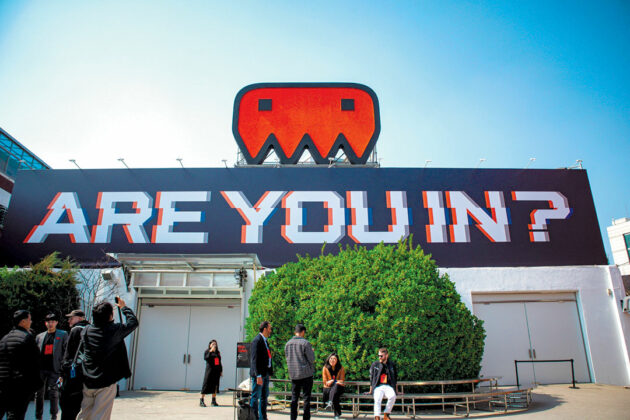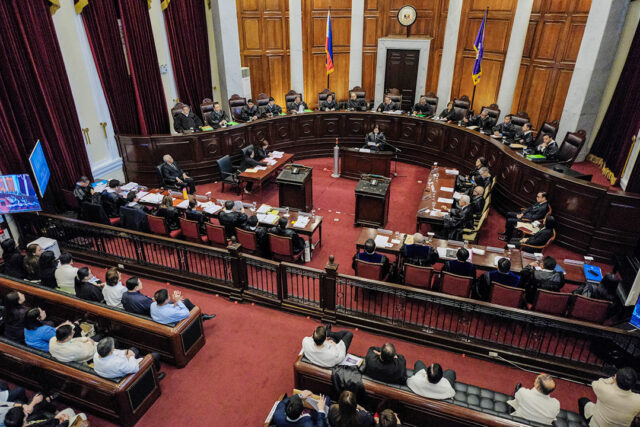A labor of love
Michael Leyva’s bridal fashion show at The Pen
DESIGNER Michael Leyva closed the Manila Peninsula’s bridal fair, “Weddings at The Peninsula and More,” with a grand fashion show, starring his latest bridal and couture collection. Mr. Leyva has dressed celebrities like Kris Aquino (particularly during her turn on the emerald carpet for the Hollywood film Crazy Rich Asians) and Anne Curtis.
For the show on April 6, the great marble frontispiece of The Peninsula’s staircase was covered up and draped, the models coming out of the two staircases on the side. A model first appeared on the mezzanine’s balcony, then two more appeared from the sides, like figures in a music box — then disappearing.
The show began in earnest with a dress with a tight bodice wrapped around the body, paired with a flared skirt. The sleeves and bodice were scattered with larger-than-life white roses, and another white rose pinned to a hat. The next look was pared down with a simple sleeveless bodice with a giant skirt covered all over with silk petals, while a third dress had a sweetheart neckline with a draped silk skirt. The menswear choices were limited to tuxedos in jewel tones (no complaints here).
Another dress seemed inspired by the Art Deco era, with a halter neck, and completely beaded all over. The throwback to the 1930s continued with a tiered lace skirt topped with a jacket, and a slinky sheath dress, stark as a Greek column, with the same big white roses on the shoulder and the bust. There was a sleeveless bodice rising up to cover the shoulder, the rest of the dress had a tiny bow at the waist, also scattered with floral appliques.
The collection played a lot with volume: we saw a dress resembling the 2000s bandage dress, tight; but given body with a puffed-up silk shawl. The same puffs and drapes were seen all over, such as in a bright, slinky magenta number. Another halter dress with a fringe had the skirt scrunched up around the waist like a cloud of fabric. A teal number mimicked the same effect with a voluminous sleeve. There was a lovely delicate high-necked dress with an overlay of lace, then another little terno (the Filipina traditional dress with butterfly sleeves) with a circle skirt and a pattern in black recalling cathedral windows.
The show came alive with the background music from The White Lotus, Season 2, a great contrast to the rather somber black terno with a giant white rose on the bodice; its skirt gathered, draped, and dropping below the waist. This was followed by a gray number with an accordion skirt, the aforementioned voluminous shawls and skirts, and an amethyst-colored suit. We saw an emerald dress, draped like a sack, held up by straps, and a nice little cocktail dress sewn to look like a single rose.
Mr. Leyva also did three-dimensional effects with his clothes, such as in a nice brown silk suit with flowers in the same color and material, rising out of the suit like a bas-relief. We saw the same effect on a simple gray corseted gown, and a slinky purple dress. A spectacle was a pair of twins in identical brown dresses, which can be altered by pulling at the tendrils on them.
One might think gray dresses are for the drab and shy, but not one of these gowns was meant for wallflowers. Mr. Leyva showed off a big gray dress with a massive ballgown skirt of layered tulle, then an aubergine drop-waisted number with a skirt that flared out (think of it like this decade’s robe de style); this one was worn with a black head ornament like a bubble of vines.
The show and the songs were reaching a climax with a magnificent off-shoulder red dress with fringe sleeves, a hooded black gown with priestess sleeves, and an accordion skirt on an otherwise sleek black sheath, topped off with a cheeky velvet wide-brimmed hat.
For the finale, Mr. Leyva brought out a huge red dress with a ballgown skirt covered in tiny red ruffles that probably took hundreds of man-hours to make: in rose red, the illusion was a flower come to life.
The allusions to flowers were no coincidence: the collection was named “Memoria ng Hardin” (Memory of a Garden). The collection is a tribute to his late brother Brian, himself a designer before his demise. “Every stitch, fold, and delicate detail is a labor of love,” said Mr. Leyva in a statement. “This collection is a narrative of gratitude, remembrance, and celebration.
“Designing this collection for The Peninsula show allowed me to pour my heart into each piece. It’s more than just fashion — it’s a celebration of love, dreams, and timeless beauty,” he said.
For more information, follow Michael Leyva at https://www.instagram.com/michaelleyva_/ — Joseph L. Garcia
































